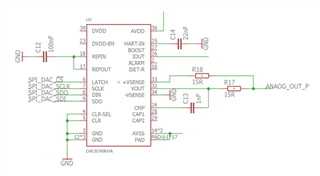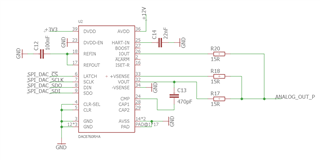Other Parts Discussed in Thread: OPA192, , , TIPD119
Hi, I have some questions, could you please help me?
1. Unused HART-IN
Do I have to tie HART-IN pin to GND through a 22 nF capacitor or can I leave it floating?
2. Does the DAC only support SPI mode 0?
3. LATCH
Can I tie this pin (/CS) to GND?
4. CMP capacitor
Do you recommend to add a capacitor (e.g. 1 nF) connected between VOUT and CMP pin?
5. DVDD and DVDD-EN
I use a 3.3 V microcontroller. Is it ok to interface the microcontroller with the DAC without connecting an external 3.3 V power-supply but using (for DVDD) its internal 5 V supply then leave DVDD and DVDD-EN pins unconnected?
6. ISET-R
Do you recommend to connect a 15 kOhm resistor to ISET-R?
7. Single-supply operation
I am interested in 0 (or 4)-20 mA and 0-10V output, is the DAC in single supply mode ok? E.g. AVDD = 24V and AVSS = GND
Do you recommend to regulate the voltage or can I directly use the voltage from a 24V wall adapter?
8. What do you recommend for power saving when the analog output is not necessary?
9. IOUT and VOUT
I short the pins IOUT and VOUT. Do you recommend adding resistors, e.g., 15 Ohm and/or capacitor e.g. 100nF?
10. VSENSE
Is it highly recommended sensing the load using VSENSE?
Can I simply connect +VSENSE to VOUT with another 15 Ohm resistor and tie -VSENSE to GND?
In other application notes an OPA192 is used, do you recommend that I use it as well? In case, could I use it in single supply (24V) mode see above?
11. CAP1 and CAP2
I want to leave CAP1 and CAP2 unconnected, do you see any downsides?
12. Currently, I don't have galvanic isolation, I don't have space for an isolator. Is that a problem?
13. What minimum EMC protection should I provide?
14. Do you have any other recommendations?
Thank you for your support!


